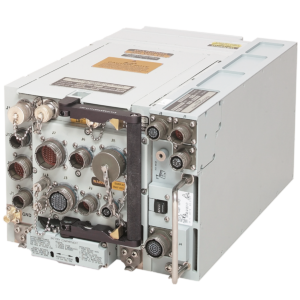Link 16 is a Tactical Data Link (TDL) developed by ViaSat Inc. and Data Link Solutions (DLS) LLC that networks communication between land, sea, and air forces to support joint operations and improve interoperability.[1] The system is critical for interoperability of NATO and coalition forces operating within a single battlespace. It is also used by the U.S. Navy and U.S. Army for air and sea operations, as well as air and missile defense.
It allows for real-time transfer of combat data, voice communications, imagery, and relative navigation information between dispersed battle elements, using data encryption and frequency hopping to maintain secure communications.[2][3] The system facilitates the exchange of data over a common communication link, allowing participants to obtain and share situational awareness information and interoperate within the battlespace. Link 16 also facilitates the exchange of sensor information, enabling command and control centers—either centralized or distributed—to create Common Operating Pictures (COP).[4] Interoperability provided by Link 16 allows each participant in the communication link to electronically observe the battlespace, identify threats, and acquire targets.[5]
Link 16 information is commonly broadcasted through radio frequency bearers, but it can also distribute information via landlines, satellites, and serial links. It is a sophisticated radio designed to broadcast omni-directionally, providing maximum interoperability for dispersed and/or fast-moving participants. Messages sent via Link 16 can be broadcast simultaneously to as many users as needed.
What sets Link 16 apart from other tactical data links is that it does not depend on any one terminal to act as a node for the Link 16 network. Instead, all Link 16-capable terminals act as nodes, allowing various military forces to operate while distributed.[6] Link 16’s unique data link architecture allows troops to conduct operations with flexibility in unpredictable battlespace environments and is critical for force interoperability against future threats.

MIDS LVT terminal
The latest generation of Link 16 equipment is the Multifunctional Information Distribution System Low Volume Terminal (MIDS LVT), which is a small unit fitted on airborne, ground, and maritime platforms that incorporates secure data and voice transfer capabilities.[7] The MIDS LVT program was initiated by a Memorandum of Understanding amongst Germany, Italy, Spain, France, and the United States.[8] MIDS LVT terminals have been installed on most U.S. fighters, bombers, rotary-wing aircraft, UAVs, tankers, and incorporate most U.S. air and missile defense systems. Link 16 is also used at mobile and fixed U.S. military command bases. In contrast to the United States, many NATO countries have been slow and less comprehensive in their integration of Link 16.[9] In total, Link 16 terminals have been installed on more than 19 land, sea, and air platforms and are fielded by over a dozen countries.[10]
Capabilities[11]
- Allows for real-time transfer of combat data, voice communications, imagery, and relative navigation information between dispersed battle elements
- Facilitates the exchange of data over a common communication link, allowing participants to obtain and share situational awareness information
- Facilitates the exchange of sensor information, enabling command and control centers to create COPs
- Enables information dissemination from command and control centers and warfighters, as well as information exchanges between warfighters
Application for Air and Missile Defense
The primary purpose of Link 16 is as an air and missile defense command and control system.[12] It is typically employed for national air defense, linking numerous air defense assets with sea- and land-based platforms such as Aegis-equipped vessels, ground-based sensors, and surface-to-air missile systems. Once interconnected via Link 16, these various systems are capable of establishing a COP within the national airspace, allowing commanders to identify threats and deal with them accordingly.
The system is also used by U.S. combatant commands for air and missile defense missions. The U.S. Navy is a heavy user of Link 16 for air and missile defense, equipping its aircraft and Aegis-equipped guided-missile vessels with the command and control system. The U.S. Army also uses Link 16 for air and missile defense, integrating command and control centers as well as ground platforms such as Patriot and THAAD into the Link 16 network.[13] Other sensor and intelligence-gathering platforms employ Link 16 to transmit relevant air and missile threat data to corresponding sensors and defense systems.[14] This interoperability between sensors, aircraft, maritime units, command and control stations, and air and missile defense systems allows for increased defensive capabilities such as target engagement beyond line-of-sight and Launch-on-Remote.[15]
Current Developments
DLS LLC and ViaSat Inc. are collaborating in development of MIDS JTRS (Joint Tactical Radio System), which is a next generation software-defined Link 16 terminal. JTRS was generally approved for full production and fielding in April 2012 and its software-defined capability will allow the terminal to integrate more platforms into Link 16.[16]
Once MIDS JTRS is implemented, other technological capabilities become available. One capability is called Tactical Targeting Network Technology (TTNT) waveform, which is an IP-based, auto-forming mesh network that can integrate over 200 platforms, even while traveling at high speeds.[17] TTNT automatically prioritizes data traffic, allowing units equipped with Link 16 to maintain COPs without networking assistance from communication satellites.[18] Another capability is called Talon HATE, which is a pod that employs MIDS JTRS to enable communication with stealth fighters that use different datalinks to avoid revealing their location.[19]
Recent News
Timeline
August 24, 2015: ViaSat Inc. and DTS LLC have been awarded contracts valuing $514.3 million and $366.5 million respectively to produce and maintain the MIDS LVT communication system.[20]
August 7, 2015: The U.S. Department of Defense proposed a $71.5 million six-year program to upgrade U.S. AV-8B Harriers with the Link 16 datalink system.[21]
September 16, 2014: Boeing completed the final design review for the Talon HATE pod program.[22]
August 19, 2014: U.S. Space and Naval Warfare Systems Command (SPAWAR) issued a pair of contracts to DLS LLC ($124.3 million) and ViaSat Inc. ($72.7 million) to add TTNT waveform to MIDS JTRS. Work is expected to be completed by August 2017.[23]
July 30, 2014: U.S. SPAWAR issued a combined $116.75 million modification contract to DLS LLC and ViaSat Inc. to exercise options for MIDS LVT and MIDS JTRS engineering and integration.[24]
2013: MIDS LVT orders from the United States, Australia, Germany, Japan, Oman, Poland, Saudi Arabia, Thailand, Turkey, and the United Arab Emirates. MIDS JTRS was tested and declared operationally effective on the U.S. Super Hornet and E-8C JSTARS.[25]
February 12, 2013: During FTM-20, a U.S. Aegis vessel intercepted a target missile using data transmitted from STSS satellites via Link 16. Integrated link architecture provided by Link 16 allowed the Aegis vessel to Launch-on-Remote, using tracking data transmitted from STSS satellites.[26]
2012: MIDS JTRS production and fielding approved for Super Hornets, E-8C, and RC-135s. MIDS LVT orders from the United States, Finland, Saudi Arabia, South Korea, and Taiwan.[27]
2011: MIDS LVT orders from the United States, Australia, Bulgaria, Italy, Japan, Lithuania, and Romania. Requests for Link 16 from the United Arab Emirates and Saudi Arabia.[28]
2010: MIDS LVT orders from the United States, Australia, Finland, Germany, Japan, Saudi Arabia, Singapore, South Korea, and Sweden. Requests for MIDS LVT from Taiwan. MIDS JTRS is ordered for limited production.[29]
2009: MIDS LVT orders from the United States, Belgium, Canada, Finland, Germany, Hungary, Japan, Norway, Poland, Saudi Arabia, South Korea, and Switzerland.[30]
June 16, 2009: The first MIDS JTRS was delivered to the U.S. government.[31]
2008: MIDS LVT orders from the United States, Hungary, and Japan. Finland, Saudi Arabia, and the United Arab Emirates requested Link 16. The United Kingdom issued a $12.2 million order to equip its Tornado strike aircraft with MIDS JTIDS terminals.[32]
2007: MIDS LVT orders from the United States, Belgium, Finland, Germany, Greece, Japan, Poland, Portugal, Taiwan, and Turkey. The Netherlands undergoes a large-scale Link 16 project, and Spain moves to improve its Link 16 compatibility.[33]
2006: MIDS LVTs were ordered by the United States, Australia, Germany, Portugal, Poland, Switzerland, and Turkey. Requests for the systems came from Greece, Pakistan, and Turkey. Canada selected DLS LLC to provide Canadian forces with MIDS LVTs.[34]
March 26, 2005: Turkey requested a $1.1. billion program to modernize its F-16 fleet, including Link 16 integration. ViaSat was selected to supply 203 MIDS LVT terminals for the order.[35]
2004-2005: ViaSat Inc. and DLS LLC were awarded contracts for MIDS LVTs, which were ordered by the United States, Australia, Belgium, Canada, Japan, New Zealand, Switzerland, and Taiwan.[36]
Late-1990s: JTIDS Class 1 terminals were replaced by smaller JTIDS Class 2H terminals and Link 16 was implemented on more airborne platforms.[37]
1992: The Operational Special Project was created to test data links in various aircraft.[38]
Mid-1980s: Link 16 became operational in the U.S. military with introduction of the Class 1 JTIDS terminal. Link 16 was limited to deployment with command and control platforms.[39]
1970s: Link 16 development began in the United States.[40]
Sources
[1] https://www.thalesgroup.com/sites/default/files/asset/document/White%20Paper%20-%20Link%2016%20Overview.pdf
[2] http://www.defenseindustrydaily.com/the-wonders-of-link-16-for-less-midslvts-updated-02471/
[3] https://www.thalesgroup.com/sites/default/files/asset/document/White%20Paper%20-%20Link%2016%20Overview.pdf
[4] https://www.thalesgroup.com/sites/default/files/asset/document/White%20Paper%20-%20Link%2016%20Overview.pdf
[5] http://www.defenseindustrydaily.com/the-wonders-of-link-16-for-less-midslvts-updated-02471/
[6] Marconi, “Link-16 Description.” Link-16 description by GEC-Marconi.docx
[7] http://www.datalinksolutions.net/products/mids-lvt.php
[8] http://www.datalinksolutions.net/products/mids-lvt.php
[9] http://www.defenseindustrydaily.com/the-wonders-of-link-16-for-less-midslvts-updated-02471/
[10] http://www.defenseindustrydaily.com/the-wonders-of-link-16-for-less-midslvts-updated-02471/
[11] https://www.thalesgroup.com/sites/default/files/asset/document/White%20Paper%20-%20Link%2016%20Overview.pdf
[12] Marconi, “Link-16 Description.” Link-16 description by GEC-Marconi.docx
[13] Marconi, “Link-16 Description.” Link-16 description by GEC-Marconi.docx
[14] Marconi, “Link-16 Description.” Link-16 description by GEC-Marconi.docx
[15] Marconi, “Link-16 Description.” Link-16 description by GEC-Marconi.docx
[16] http://www.defenseindustrydaily.com/the-wonders-of-link-16-for-less-midslvts-updated-02471/
[17] http://www.defenseindustrydaily.com/the-wonders-of-link-16-for-less-midslvts-updated-02471/
[18] http://www.defenseindustrydaily.com/the-wonders-of-link-16-for-less-midslvts-updated-02471/
[19] http://www.defenseindustrydaily.com/the-wonders-of-link-16-for-less-midslvts-updated-02471/
[20] https://www.defense.gov/News/Contracts/Contract-View/Article/614467
[21] https://news.usni.org/2015/08/04/pentagon-requests-funding-to-accelerate-harrier-data-link-upgrades
[22] http://www.defenseindustrydaily.com/the-wonders-of-link-16-for-less-midslvts-updated-02471/
[23] http://www.defenseindustrydaily.com/the-wonders-of-link-16-for-less-midslvts-updated-02471/
[24] http://www.defenseindustrydaily.com/the-wonders-of-link-16-for-less-midslvts-updated-02471/
[25] http://www.defenseindustrydaily.com/the-wonders-of-link-16-for-less-midslvts-updated-02471/
[26] http://www.defenseinnovationmarketplace.mil/resources/MDASpaceMissileBrief2013.pdf
[27] http://www.defenseindustrydaily.com/the-wonders-of-link-16-for-less-midslvts-updated-02471/
[28] http://www.defenseindustrydaily.com/the-wonders-of-link-16-for-less-midslvts-updated-02471/
[29] http://www.defenseindustrydaily.com/the-wonders-of-link-16-for-less-midslvts-updated-02471/
[30] http://www.defenseindustrydaily.com/the-wonders-of-link-16-for-less-midslvts-updated-02471/
[31] http://www.defenseindustrydaily.com/the-wonders-of-link-16-for-less-midslvts-updated-02471/
[32] http://www.defenseindustrydaily.com/the-wonders-of-link-16-for-less-midslvts-updated-02471/
[33] http://www.defenseindustrydaily.com/the-wonders-of-link-16-for-less-midslvts-updated-02471/
[34] http://www.defenseindustrydaily.com/the-wonders-of-link-16-for-less-midslvts-updated-02471/
[35] http://www.defenseindustrydaily.com/the-wonders-of-link-16-for-less-midslvts-updated-02471/
[36] http://www.defenseindustrydaily.com/the-wonders-of-link-16-for-less-midslvts-updated-02471/
[37] http://www.northropgrumman.com/Capabilities/DataLinkProcessingAndManagement/Documents/Understanding_Voice+Data_Link_Networking.pdf
[38] http://www.northropgrumman.com/Capabilities/DataLinkProcessingAndManagement/Documents/Understanding_Voice+Data_Link_Networking.pdf
[39] http://www.northropgrumman.com/Capabilities/DataLinkProcessingAndManagement/Documents/Understanding_Voice+Data_Link_Networking.pdf
[40] http://www.northropgrumman.com/Capabilities/DataLinkProcessingAndManagement/Documents/Understanding_Voice+Data_Link_Networking.pdf

